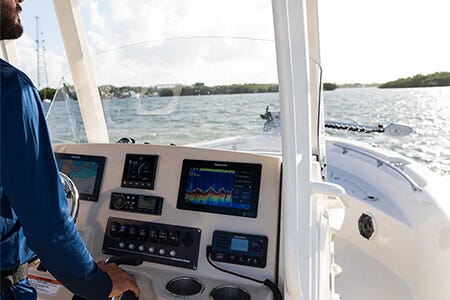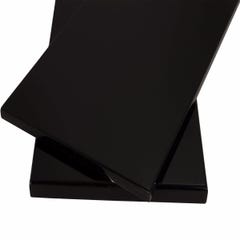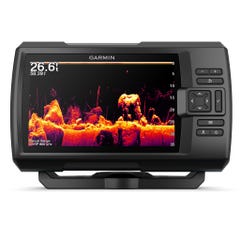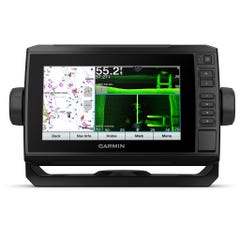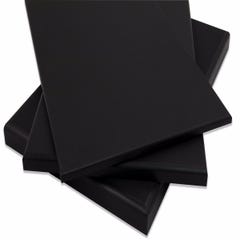Sonar 101: A Beginner’s Guide to Reading a Fish Finder
January 31, 2024 11 min read


Reading a fish finder is a bit like reading the stars. There’s a whole lot of information in there, but interpreting it can be mysterious and daunting. Thanks to YouTube and the internet, there are plenty of resources out there to understand the technical aspects, but these resources will be better understood if you have a broader framework to apply them to.
If you are new to using electronics to find fish, there are very consistent milestones you can expect to encounter as you learn how to read a fish finder; knowing what that process will look like will help you focus your learning where it will provide the most benefit.
Fish Finder Milestone 1: Proper Perspective
I remember well the first fish finder I got. I simply couldn’t believe how many fish were popping up on the screen. What had appeared to my naked eye as empty water was suddenly crowded with strange sonar blips drifting across my screen. Immediately my fishing changed. I slowed down and started targeting the fish blips that were showing up on the screen. Every blip was an exciting possibility that required investigation. That was “Milestone 1” for me, and I learned two important lessons from it:
1. There are a lot more fish around than you think they are.
2. Being around fish does not mean you will catch them. Those two realizations left me more frustrated than encouraged.
What had appeared to my naked eye as empty water was suddenly crowded with strange sonar blips drifting across my screen.
Fish Finder Milestone 2: Build on What You Already Know
If my first impression of my fish finder was a false hope that it would magically help me catch more fish, my second impression was that it was a gimmick that was worse than useless, almost laughing at me by showing the fish that I wasn’t going to catch.
With this realization, my first reaction was to ignore it completely and focus on the visual clues I’d learned previously — points, transitions, land contours, etc. I continued to catch fish the way I had previously, no thanks to the expensive electronic equipment that sat uselessly on my console.
Eventually, after catching a fish, I found myself asking the obvious question, “Why was that fish here?” It was not a new question, but it finally dawned on me that I had a new tool to help answer the question. After each catch, I drove over to the spot where the bite occurred, using the fish finder to help answer the question. Sure enough, where there was a fish, there was a submerged stump, a ledge, or some other feature that suddenly explained my success.
Eventually, after catching a fish, I found myself asking the obvious question, “Why was that fish here?”
With these realizations, I arrived at Milestone 2 — using the fish finder to understand why fish were where they were. With increasing frequency, I found myself glancing at the fish finder in conjunction with the visual clues I already understood, realizing eventually that the fish finder shouldn’t replace other available clues, but it could add to them.
I started paying less attention to the fish blips and more attention to what was below them – the bottom. The points, cliffs, and transitions that I could identify visually from the land suddenly formed a continuous shape with what I could see on my fish finder. I could mentally draw lines from what was in front of me to what was below me. I wasn’t finding fish, I was finding places where fish were likely to be.
I wasn’t finding fish, I was finding places where fish were likely to be.
If milestone 1 made me realize that there were more fish around me than I realized, milestone 2 helped me to learn the places where they were more likely to be feeding. What I had originally hoped to be a “fish finder” became a “bottom finder,” and I began to apply what I already knew with a new set of information provided by my electronics. And I was quickly, if unwittingly, moving towards Milestone 3.
Fish Finder Milestone 3: Converting Spots to Patterns
Up to this point, I was building on what I already knew and letting the fish finder add to it. I knew that a certain point looked fishy, and the fish finder told me exactly where on the point the fish were likely to hang. I’d learned through trial and error that a certain spot often held fish, and the fish finder showed me the stumps, rockpiles, and ledges that explained why.
I’d learned through trial and error that a certain spot often held fish, and the fish finder showed me the stumps, rockpiles, and ledges that explained why.
Slowly, and without being conscious of it, my entire approach shifted dramatically on its axis. When I started, I was going to spots I knew, and letting the electronics confirm and enhance my understanding of them. The more I did this the more I started to identify patterns, then look for spots that were likely to have them.
If my “go-to” honey hole had a point, a ledge, and a rock pile, then I could look for other points with those same characteristics and add them to my honey hole list. Milestone 3 arrived with two new lessons:
1. Use the fish finder to understand the pattern.
2. Use the pattern to find more fish.
Fish Finder Milestone 4: Break from the Bank
By now, my journey had taken me through the highs of expecting too much from my fish finder to the lows of ignoring it completely, before settling into a new balance of using it in conjunction with what I already knew. But my journey continued and there was another milestone coming. And it opened up an entire universe I had never considered.
Because my pre-fish finder experience had been entirely reliant on visual clues, all of my fishing was within a single cast of the bank. However, at some point, the realization dawned on me that the same features that exist near the bank can exist offshore as well. I knew the patterns, and with Milestone 4 I began to loosen my reliance on land-based clues and search for those same patterns using only my fish finder.
At some point, the realization dawned on me that the same features that exist near the bank can exist offshore as well.
This is when I learned the power of side-scan sonar waves. Trying to find underwater features solely in the down view mode was a tedious exercise requiring extreme luck or disciplined grid searches. Side scan allowed me to spot the features I was looking for while idling, marking points of interest, and then navigating back to them for a closer look using down imaging. It is a strange feeling to work in open water, but only to fishermen. For the fish, the only difference is depth.
Shortening the Fish Finder Learning Curve
My own journey into fishing electronics continues, and I have recently begun learning to use active sonar (Garmin Livescope) which shows fish movement in real-time. I find myself, once again, re-living these milestones, learning how to incorporate newer and more advanced technology into what I already know.
Your journey with fishing electronics may be slightly different depending on the waters that you fish, but the milestones will be the same. There is no replacement for time on the water, but recognizing the milestones as you pass them will help shorten your learning curve. As you embark on this journey, here are some tips that will help you accelerate your learning:
1. Milestone 1: Remember, it’s only a fish finder to the extent that it finds places where fish exist. Think of it as a “bottom finder” and use it accordingly. Don’t waste a lot of time targeting the fish you see on the fish finder screen; focus on what is beneath or around them.
2. Milestone 2: As you start your journey, do not let your electronics take the lead. Do what you’ve always done — focus on what you know, then use your electronics to tell you why fish were where you found them. Look past the tantalizing fish “blips” and focus on what is around them — the bottom contours, structure, and the type of bottom (soft vs. hard bottom). If you see strong concentrations of fish, pay close attention and ask the obvious question: why are they there?
3. Milestone 3: Translate your “spots” into patterns. You already knew a few places that held fish, and now you’ve used your electronics to better understand why those spots are productive. Take that knowledge and generalize it. What is the pattern? Where else does it present itself? I fish for striper on a local river, and a consistent pattern is finding long, shallow shelves that drop suddenly into 20 feet of water. If there is timber or a creek nearby, even better. I found fish in one spot like that and then used my electronics to find similar combinations. Lo and behold, there were fish at nearly every one.
4. Milestone 4: Leave the bank. Ninety percent of fishermen work banks, but that doesn’t mean that ninety percent of the fish are on the bank. There are just as many fish — and arguably more — on offshore structures that have the same characteristics as those near the banks, and these fish get far less pressure.
Balance Research With Experience
Your fish finder is going to tell you that there is a lot more going on in your body of water than you thought there was, and it’s accurate. It will take time to recalibrate your understanding of when to stop and work an area and when to keep moving.
Along the way, your ability to interpret what your electronics are telling you will evolve. Research will help, but there is no replacement for simply watching the screen long enough to allow your brain to build the proper framework and reference points.
Research will help, but there is no replacement for watching the screen long enough to allow your brain to build the proper framework and reference points.
Balance research with experience on the water and be patient. There is a reason that you don’t find pros huddled over their electronics. They recognize that the “eyes” of their electronics don’t replace the eyes they were born with, but their “electronic eyes” can enhance their understanding of what is happening below them.
Most of all, enjoy the journey and experiment a little. On the other side of your journey is a fisherman who never loses sight of the world around them, but whose understanding of that world is enhanced by technology.
Quick Tips for How to Read Your Fish Finder
Learning to use your fish finder to catch more fish involves much more than simply learning what fish look like on the screen. That being said, here are a few specific tips about how to read your fish finder:
- A fish finder works by transmitting sonar “pings” into the water through the transducer. The transducer generates a cone directly under your boat that widens more as depth increases. Any return you see could be anywhere within that cone.
- The side-to-side position of an image on screen has nothing to do with its location on your boat. Everything to the left of the right-hand edge of your screen is “history.” In other words, the information on the right-hand edge represents what’s inside the cone right now. The information farther to the left shows what was in the cone a few moments ago.
- Higher frequency settings like 200kHz produce more detailed images but can’t “see” as deep as lower frequencies. A lower frequency like 50kHz works better in deeper water.
- Hard objects' bottom will typically display in brighter colors and softer colors will appear darker (blue). From a hardness perspective (strength of signal return), the colors go from yellow (hardest) to orange, red, and finally blue (softest/weakest return). So, a hard, sandy bottom may appear yellow or orange, while a soft mud bottom may appear red or blue.
- The underwater structure will show similar color displays, with hard objects (rocks/submerged roads, etc.) showing up yellow/orange) and timber showing up red or blue.
- Fish will appear as arches, but the length of the arch does not indicate the size of the fish, only how long it was in the transducer cone. The thickness of the fish arch does indicate size, and some fish can be more visible based on the strength of the return; the swim bladder in some fish generates a hard (yellow/orange) return, making it easier to differentiate them from surrounding bait schools.
- Bait schools of fish will appear as blobs instead of arches on the screen.
When it comes to fishing, a fish finder can be one of your most valuable tools. With the right know-how, you can use a fish finder to maximize your chances of finding and catching the big one. Knowing how to read a fish finder can make all the difference when it comes to success on the water.
Reading a fish finder is not overly complicated but does require some practice. With the tips and tricks provided above, you will soon be a pro at recognizing fish, structure, and bait on your electronics. Above all else, remember to have fun and enjoy the journey!

